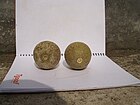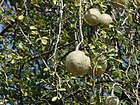Note: This is a project under development. The articles on this wiki are just being initiated and broadly incomplete. You can Help creating new pages.
Difference between revisions of "Limonia acidissima - Kapitha"
(→List of Ayurvedic medicine in which the herb is used) |
(→References) |
||
| (10 intermediate revisions by 2 users not shown) | |||
| Line 1: | Line 1: | ||
[[File:Limonia acidissima (6941726106).jpg|thumb|right|''Kapitha'', ''Limonia acidissima'']] | [[File:Limonia acidissima (6941726106).jpg|thumb|right|''Kapitha'', ''Limonia acidissima'']] | ||
'''Limonia acidissima''' is the only species within the monotypic genus Limonia. It is native to the Indomalaya ecozone to Bangladesh, India, Pakistan, Sri Lanka, and in Indochinese ecoregion east to Java and the Malesia ecoregion. | '''Limonia acidissima''' is the only species within the monotypic genus Limonia. It is native to the Indomalaya ecozone to Bangladesh, India, Pakistan, Sri Lanka, and in Indochinese ecoregion east to Java and the Malesia ecoregion. | ||
| + | ==Uses== | ||
| + | {{Uses|Indigestion}}, {{Uses|Earache}}, {{Uses|Scurvy}}, {{Uses|Diabetes}}, {{Uses|Kidney problems}}, {{Uses|Liver problems}}, {{Uses|Snakebites}}, {{Uses|Malaria}}, {{Uses|Sore throats}}.<ref name="Uses"/> | ||
| − | == | + | ===Food=== |
| − | + | Limonia acidissima can be used in Food. Pulp of ripe fruits is eaten raw and used in preparation of soft drink and jam.<ref name="Forest foods of Western Ghat"/> | |
==Parts Used== | ==Parts Used== | ||
| Line 9: | Line 11: | ||
==Chemical Composition== | ==Chemical Composition== | ||
| − | Fruit pulp contains large quantity of citric acid and other fruit acids, mucilage and minerals. | + | Fruit pulp contains large quantity of citric acid and other fruit acids, mucilage and minerals.<ref name="chemical composition"/> |
==Common names== | ==Common names== | ||
| Line 29: | Line 31: | ||
===Prabhava=== | ===Prabhava=== | ||
| + | |||
| + | ===Nutritional components=== | ||
| + | Limonia acidissima Contains the Following nutritional components like - Vitamin-C; Phosphorus, Magnesium, Calcium, Sodium, Potassium<ref name="Forest foods of Western Ghat"/> | ||
==Habit== | ==Habit== | ||
| Line 35: | Line 40: | ||
==Identification== | ==Identification== | ||
===Leaf=== | ===Leaf=== | ||
| − | {{Leaf|Pinnate| | + | {{Leaf|Pinnate|Alternate|Imparipinnate, alternate, 1-3 in a cluster, estipulate; rachis 60-80 mm long, stout, glabrous, often narrowly winged.}}<ref name="Leaf"/> |
===Flower=== | ===Flower=== | ||
| − | {{Flower|Polygamous|1-3 cm across|Yellow|10-12| | + | {{Flower|Polygamous|1-3 cm across|Yellow|10-12|Dull red, 1.3 cm across, in axillary cymes; calyx small, flat, 5-toothed, pubescent with out, deciduous. Flowering season is November to March}} |
===Fruit=== | ===Fruit=== | ||
| − | {{Fruit|Berry|5-7.6 cm across|| | + | {{Fruit|Berry|5-7.6 cm across||Globose, whitish-brown, rind hard and woody; seeds many, embedded in pulp|Many|Fruiting season is November to March }} |
===Other features=== | ===Other features=== | ||
| Line 48: | Line 53: | ||
* [[Nyagrodhadi churna]] | * [[Nyagrodhadi churna]] | ||
* [[Dashamoolarishta]] | * [[Dashamoolarishta]] | ||
| − | <ref name="Ayurvedic preparations"/> | + | <ref name="Ayurvedic preparations"/> |
==Where to get the saplings== | ==Where to get the saplings== | ||
| Line 55: | Line 60: | ||
==How to plant/cultivate== | ==How to plant/cultivate== | ||
| − | + | The wood-apple is generally grown from seeds though seedlings will not bear fruit until at least 15 years old. Multiplication may also be by root cuttings, air-layers, or by budding<ref name="How to plant/cultivate"/>. Limonia acidissima available through March to August<ref name="Forest foods of Western Ghat"/>. | |
==Commonly seen growing in areas== | ==Commonly seen growing in areas== | ||
| Line 62: | Line 67: | ||
==Photo Gallery== | ==Photo Gallery== | ||
<gallery class="left" caption="" widths="140px" heights="140px"> | <gallery class="left" caption="" widths="140px" heights="140px"> | ||
| − | |||
Coth bael.jpg | Coth bael.jpg | ||
| − | |||
Feronia elephantum Govindoo.jpg | Feronia elephantum Govindoo.jpg | ||
| − | |||
| − | |||
Feronia elephantum PannaTR.jpg | Feronia elephantum PannaTR.jpg | ||
| − | |||
| − | |||
Feronia Elephantum tree.JPG | Feronia Elephantum tree.JPG | ||
| − | |||
| − | |||
Gardenology.org-IMG 7688 qsbg11mar.jpg | Gardenology.org-IMG 7688 qsbg11mar.jpg | ||
| − | |||
| − | |||
Gardenology.org-IMG 7689 qsbg11mar.jpg | Gardenology.org-IMG 7689 qsbg11mar.jpg | ||
| − | |||
| − | |||
Kapithama (Sanskrit- कपित्थं) (2276565334).jpg | Kapithama (Sanskrit- कपित्थं) (2276565334).jpg | ||
| − | |||
| − | |||
Kapittam (Tamil- கபித்தம்) (7087799491).jpg | Kapittam (Tamil- கபித்தம்) (7087799491).jpg | ||
| − | |||
</gallery> | </gallery> | ||
==References== | ==References== | ||
| − | |||
<references> | <references> | ||
| − | <ref name="chemical composition">[http://www.mpbd.info/plants/limonia-acidissima.php | + | <ref name="chemical composition">[http://www.mpbd.info/plants/limonia-acidissima.php Chemical constituents]</ref> |
| − | + | <ref name="Leaf">Kappatagudda - A Repertoire of Medicianal Plants of Gadag by Yashpal Kshirasagar and Sonal Vrishni, Page No. 262</ref> | |
| − | <ref name=" | + | <ref name="Ayurvedic preparations">[https://easyayurveda.com/2017/12/28/wood-apple-kaitha-feronia-limonia-limonia-acidissima/ Ayurvedic preparations]</ref> |
| − | + | <ref name="How to plant/cultivate">[https://hort.purdue.edu/newcrop/morton/wood-apple.html Cultivation Details]</ref> | |
| − | <ref name="How to plant/cultivate">[ | + | <ref name="Uses">Karnataka Aushadhiya Sasyagalu By Dr.Maagadi R Gurudeva, Page no:263</ref> |
| + | <ref name="Forest foods of Western Ghat">"Forest food for Northern region of Western Ghats" by Dr. Mandar N. Datar and Dr. Anuradha S. Upadhye, Page No.105, Published by Maharashtra Association for the Cultivation of Science (MACS) Agharkar Research Institute, Gopal Ganesh Agarkar Road, Pune</ref> | ||
</references> | </references> | ||
==External Links== | ==External Links== | ||
* [https://www.organicfacts.net/health-benefits/fruit/health-benefits-of-wood-apple-or-bel-fruit.html Surprising Benefits Of Wood Apple Or Bael Fruit] | * [https://www.organicfacts.net/health-benefits/fruit/health-benefits-of-wood-apple-or-bel-fruit.html Surprising Benefits Of Wood Apple Or Bael Fruit] | ||
| − | * [http://www.globinmed.com/index.php?option=com_content&view=article&id=104652:feronia-limonia-1&catid=199&Itemid=139 | + | * [http://www.globinmed.com/index.php?option=com_content&view=article&id=104652:feronia-limonia-1&catid=199&Itemid=139 Glob in med.com] |
* [https://www.tandfonline.com/doi/abs/10.3109/14756360903514156 Constituents of Limonia acidissima inhibit LPS-induced nitric oxide production] | * [https://www.tandfonline.com/doi/abs/10.3109/14756360903514156 Constituents of Limonia acidissima inhibit LPS-induced nitric oxide production] | ||
[[Category:Herbs]] | [[Category:Herbs]] | ||
[[Category:Rutaceae]] | [[Category:Rutaceae]] | ||
Latest revision as of 11:29, 12 November 2021
Limonia acidissima is the only species within the monotypic genus Limonia. It is native to the Indomalaya ecozone to Bangladesh, India, Pakistan, Sri Lanka, and in Indochinese ecoregion east to Java and the Malesia ecoregion.
Contents
- 1 Uses
- 2 Parts Used
- 3 Chemical Composition
- 4 Common names
- 5 Properties
- 6 Habit
- 7 Identification
- 8 List of Ayurvedic medicine in which the herb is used
- 9 Where to get the saplings
- 10 Mode of Propagation
- 11 How to plant/cultivate
- 12 Commonly seen growing in areas
- 13 Photo Gallery
- 14 References
- 15 External Links
Uses
Indigestion, Earache, Scurvy, Diabetes, Kidney problems, Liver problems, Snakebites, Malaria, Sore throats.[1]
Food
Limonia acidissima can be used in Food. Pulp of ripe fruits is eaten raw and used in preparation of soft drink and jam.[2]
Parts Used
Chemical Composition
Fruit pulp contains large quantity of citric acid and other fruit acids, mucilage and minerals.[3]
Common names
| Language | Common name |
|---|---|
| Kannada | Dadhiphala, Nayibel |
| Hindi | Pushpaphal, Katabel |
| Malayalam | Vilankai, Vilarmaram |
| Tamil | Vila, Vilampazam |
| Telugu | Kapitthhamu |
| Marathi | NA |
| Gujarathi | NA |
| Punjabi | NA |
| Kashmiri | NA |
| Sanskrit | Dadhittha, Danthashatha |
| English | Wood apple, Monkey fruit |
Properties
Reference: Dravya - Substance, Rasa - Taste, Guna - Qualities, Veerya - Potency, Vipaka - Post-digesion effect, Karma - Pharmacological activity, Prabhava - Therepeutics.
Dravya
Rasa
Guna
Veerya
Vipaka
Karma
Prabhava
Nutritional components
Limonia acidissima Contains the Following nutritional components like - Vitamin-C; Phosphorus, Magnesium, Calcium, Sodium, Potassium[2]
Habit
Identification
Leaf
| Kind | Shape | Feature |
|---|---|---|
| Pinnate | Alternate | Imparipinnate, alternate, 1-3 in a cluster, estipulate; rachis 60-80 mm long, stout, glabrous, often narrowly winged. |
Flower
| Type | Size | Color and composition | Stamen | More information |
|---|---|---|---|---|
| Polygamous | 1-3 cm across | Yellow | 10-12 | Dull red, 1.3 cm across, in axillary cymes; calyx small, flat, 5-toothed, pubescent with out, deciduous. Flowering season is November to March |
Fruit
| Type | Size | Mass | Appearance | Seeds | More information |
|---|---|---|---|---|---|
| Berry | 5-7.6 cm across | Globose, whitish-brown, rind hard and woody; seeds many, embedded in pulp | Many | Fruiting season is November to March |
Other features
List of Ayurvedic medicine in which the herb is used
Where to get the saplings
Mode of Propagation
How to plant/cultivate
The wood-apple is generally grown from seeds though seedlings will not bear fruit until at least 15 years old. Multiplication may also be by root cuttings, air-layers, or by budding[6]. Limonia acidissima available through March to August[2].
Commonly seen growing in areas
Photo Gallery
References
- ↑ Karnataka Aushadhiya Sasyagalu By Dr.Maagadi R Gurudeva, Page no:263
- ↑ 2.0 2.1 2.2 "Forest food for Northern region of Western Ghats" by Dr. Mandar N. Datar and Dr. Anuradha S. Upadhye, Page No.105, Published by Maharashtra Association for the Cultivation of Science (MACS) Agharkar Research Institute, Gopal Ganesh Agarkar Road, Pune
- ↑ Chemical constituents
- ↑ Kappatagudda - A Repertoire of Medicianal Plants of Gadag by Yashpal Kshirasagar and Sonal Vrishni, Page No. 262
- ↑ Ayurvedic preparations
- ↑ Cultivation Details
External Links
- Ayurvedic Herbs known to be helpful to treat Indigestion
- Ayurvedic Herbs known to be helpful to treat Earache
- Ayurvedic Herbs known to be helpful to treat Scurvy
- Ayurvedic Herbs known to be helpful to treat Diabetes
- Ayurvedic Herbs known to be helpful to treat Kidney problems
- Ayurvedic Herbs known to be helpful to treat Liver problems
- Ayurvedic Herbs known to be helpful to treat Snakebites
- Ayurvedic Herbs known to be helpful to treat Malaria
- Ayurvedic Herbs known to be helpful to treat Sore throats
- Herbs with Fruits used in medicine
- Herbs with Leaves used in medicine
- Herbs with common name in Kannada
- Herbs with common name in Hindi
- Herbs with common name in Malayalam
- Herbs with common name in Tamil
- Herbs with common name in Telugu
- Herbs with common name in Sanskrit
- Herbs with common name in English
- Habit - Deciduous tree
- Index of Plants which can be propagated by Seeds
- Index of Plants which can be propagated by Cuttings
- Herbs that are commonly seen in the region of Dry plains
- Herbs that are commonly seen in the region of Himalayas
- Herbs
- Rutaceae








